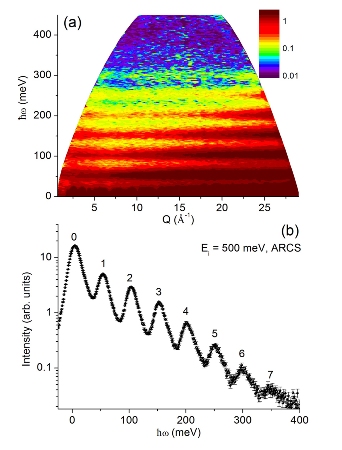Oct 24 2012
Researchers at the Department of Energy's Oak Ridge National Laboratory have found that nitrogen atoms in the compound uranium nitride exhibit unexpected, distinct vibrations that form a nearly ideal realization of a physics textbook model known as the isotropic quantum harmonic oscillator.
 A "nearly ideal realization" of a physics textbook model: Bands of scattered neutrons (colors at top) correspond to energy levels quantized in 50 meV lumps (bottom).
A "nearly ideal realization" of a physics textbook model: Bands of scattered neutrons (colors at top) correspond to energy levels quantized in 50 meV lumps (bottom).
In the experiment on the uranium nitride crystal -- with each of the light nitrogen atoms centered in a cage of heavier uranium atoms -- neutron scattering at ORNL's Spallation Neutron Source (SNS) revealed an unexpected series of distinct and evenly spaced oscillations: The nitrogen atom vibrates like a molecular-level ball on a spring.
"Students of physics are familiar with this idealized quantum 'mass on a spring,' but it is very unexpected to find such a precise literal version of this theoretical model in a real experiment," said Steve Nagler, director of ORNL's Quantum Condensed Matter Division of the Neutron Sciences Directorate and a co-author on the paper, published in the journal Nature Communications.
The researchers were using the intense neutron beams of the SNS to examine the magnetic properties of a single crystal of uranium nitride when they noticed the signatures of quantum oscillations. The researchers’ technique -- neutron scattering -- is a tool commonly used to measure conventional quantized sound waves, or "phonon excitations" that occur at low frequencies. The measurements at SNS, however, probed higher frequencies well above the “phonon cutoff”.
The new data, obtained using SNS’s wide angular-range chopper spectrometer (ARCS) and fine-resolution Fermi chopper spectrometer (SEQUOIA) instruments, revealed up to 10 equally spaced energy levels corresponding to oscillations of individual nitrogen atoms in different quantum states. The team was "astonished" to find this series of high-energy vibrational modes in uranium nitride -- particularly in an experiment that originally set out to investigate magnetism in the material.
"We learn about the quantum harmonic oscillator in undergraduate physics courses, but you never believe you will find such a good example in nature," said Adam Aczel, a postdoctoral fellow within the Quantum Condensed Matter Division and lead author on the paper.
Uranium nitride is a material of interest in that it is being considered as a fuel for the next generation of more efficient nuclear power reactors. The phenomena observed at SNS could lend valuable insight into the material's performance and behavior as a nuclear fuel.
The SNS is the world's most powerful pulsed neutron source with a suite of unique, specialized instruments in its scientific user facility for the study of advanced materials. The uranium nitride research team combined data from ARCS and SEQUOIA with computational models to better understand their findings. The crystal of uranium nitride was provided by the Canadian Neutron Beam Centre (CNBC) of the National Research Council of Canada.
The team includes Aczel, Nagler, Garrett Granroth, Doug Abernathy, Greg MacDougall, G.D. Samolyuk and Malcolm Stocks of ORNL and W.J.L. Buyers of CNBC at Chalk River.
This research was supported as part of the Center for Defect Physics, an Energy Frontier Research Center funded by the DOE Office of Science.
The Spallation Neutron Source is an Office of Science User Facility operated for the DOE Office of Science by Oak Ridge National Laboratory.